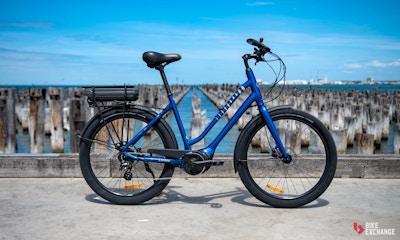Shimano is far from a perfect company, and the Japanese giant has had its fair share of misses, such as the lackluster Dura-Ace 7900 group (and its related Ultegra and 105 brethren) and the failed attempt to introduce the Dual Control concept to the mountain-bike world. With few exceptions, though, even Shimano’s duds have been hyper-engineered; it’s when that perfectionist-style engineering mindset coincides with a product the public actually wants and needs that the real magic happens.
Many have described the latest Dura-Ace 9100 groupset as an evolution of Dura-Ace 9000, rather than a revolution. In terms of tangible differences, that would be an apt description. However, making significant improvements over something that was already so good is no small feat. Getting 80% or 90% of the way to the ideal is comparatively easy, but eking out what little remains is the hard part, and that Shimano started from such an improbably high bar, yet has managed to get that much closer while maintaining familiarity, is hardly just evolution.
We’ve already covered the technical details of the new Dura-Ace 9100 groupset. Below, CyclingTips U.S. technical editor James Huang focuses on his impressions of a production setup on the road.
A SUBTLE SHIFT
Riders who hop back and forth between the new Dura-Ace 9100 and its predecessor, Dura-Ace 9000, likely won’t notice much of a difference. As before, the pleasingly sculpted lever bodies are compact and nicely shaped with no sharp edges, the shift quality is impeccably consistent and precise, the crankset is a paragon of forged aluminum artistry, and the dual-pivot brake calipers bolster any argument that disc brakes aren’t necessary.
The groupset is also light, easy to install and service, and as always, thoroughly engineered. Simply put, every single piece feels, works, and moves exactly as it should, with a reassuringly solid and precise character that reinforces the notion that they do so because someone meant for them to do so — and will likely stay that way for a long, long time. Shimano has yet to release official worldwide pricing, but our information says that the cost is holding steady, too.
The tactile differences may not be immediately obvious, but make no mistake — Dura-Ace 9100 is an improvement on Dura-Ace 9000.
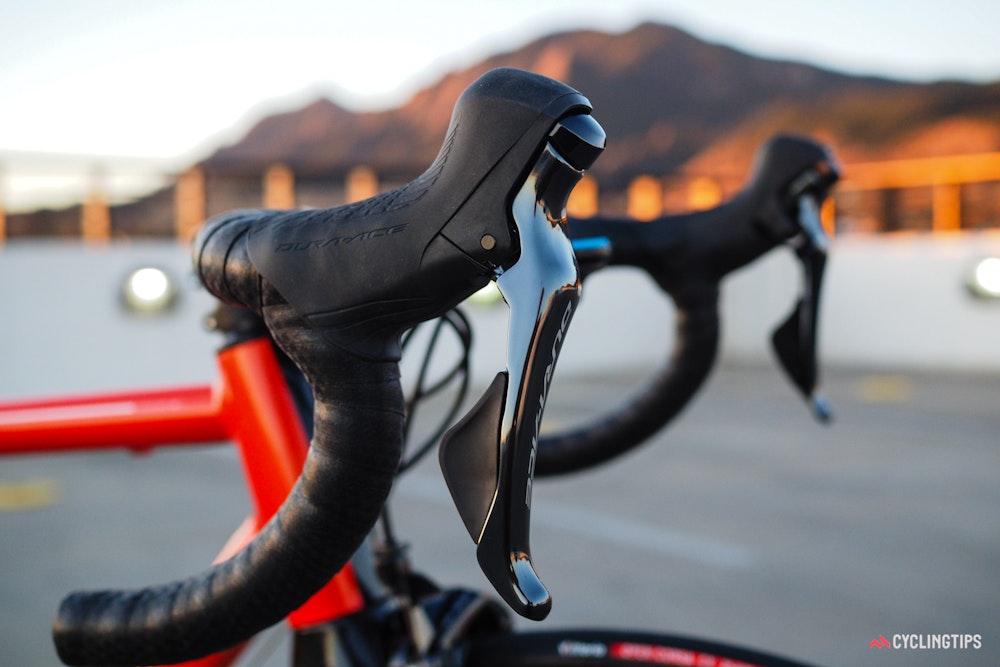
Visually, there isn’t much to differentiate the new Shimano Dura-Ace 9100 shift levers from the previous 9000-generation. Internally, though, shift lever throw has been reduced by nearly 25% for faster shifts and less hand movement, especially when making multiple shifts.
Shimano makes a big deal of the shorter shift-lever throws on Dura-Ace 9100, with a claimed 24% decrease on the main lever, and a somewhat less dramatic 14% change on the secondary lever that resides behind. Those numbers aren’t made up, and one only has to physically measure the two to verify for themselves. Nevertheless, it doesn’t feel all that much shorter on the road, and the throws are still considerably longer than SRAM’s ultra-responsive DoubleTap controls. If anything, the larger inboard shifter paddles and more generous reach adjustment range on Dura-Ace 9100 are more noticeable, as both improve the lever ergonomics for riders with smaller hands, especially while in the drops.
Campagnolo still has the upper hand on both of the other “S” brands in terms of multiple gear shifts, too, since Shimano has yet to carry over the Multi-Shift functionality from its mountain bike shifters, which allow two upshifts per lever swing instead of just one. (Upper-end Campagnolo models can dump up to four gears with a single push.)
Likewise, the new Dura-Ace 9100 dual-pivot rim brake calipers once again generate heaps of power with outstanding lever feedback. A new steel bridge joins the caliper arm pivots for reduced flex, but it mostly manifests in improved performance only under very hard braking, and slightly better modulation elsewhere in the power band. Visually, the new quick-release lever is lower in profile for a sleeker appearance, but it no longer offers indexed intermediate positions between fully open and closed.
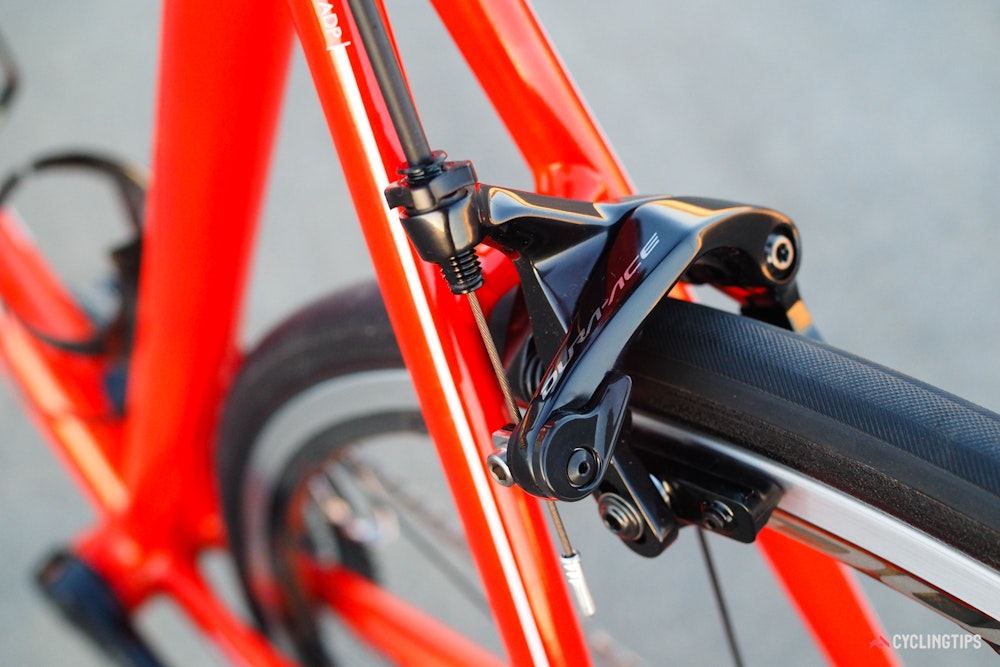
The new brakes are a subtle improvement over the previous edition, which were already arguably the best available with superb power, modulation, and feel.
Indeed, a search for those big gains in Dura-Ace 9100 will come up fruitless. The biggest changes are the ones that aren’t nearly as obvious, but are no less significant.
BORROWING FROM THE MOUNTAIN BIKE SIDE
While the sensations at the levers are familiar, the front and rear derailleur designs are grand departures from anything else Shimano has produced thus far for the road.
Out back, the new Dura-Ace 9100 rear derailleur is essentially just a short-cage version of XTR. The new-for-road “Direct Mount” upper link configuration does away with the spring-loaded upper pivot that Shimano has used for ages, and combines with a new concentric upper pulley location to provide a more consistent gap between the pulley and cassette cog across the gear range than before, no matter which chainring is used up front.
Assuming bike companies eventually develop Direct Mount-specific hangers — which would reach further back and eliminate that short upper link — the design would also allow for faster wheel changes (since there would be more room for the axle ends to drop out of the frame) and, provided a proper hanger design, theoretically make for better shifting performance thanks to a stiffer and stouter mounting point.
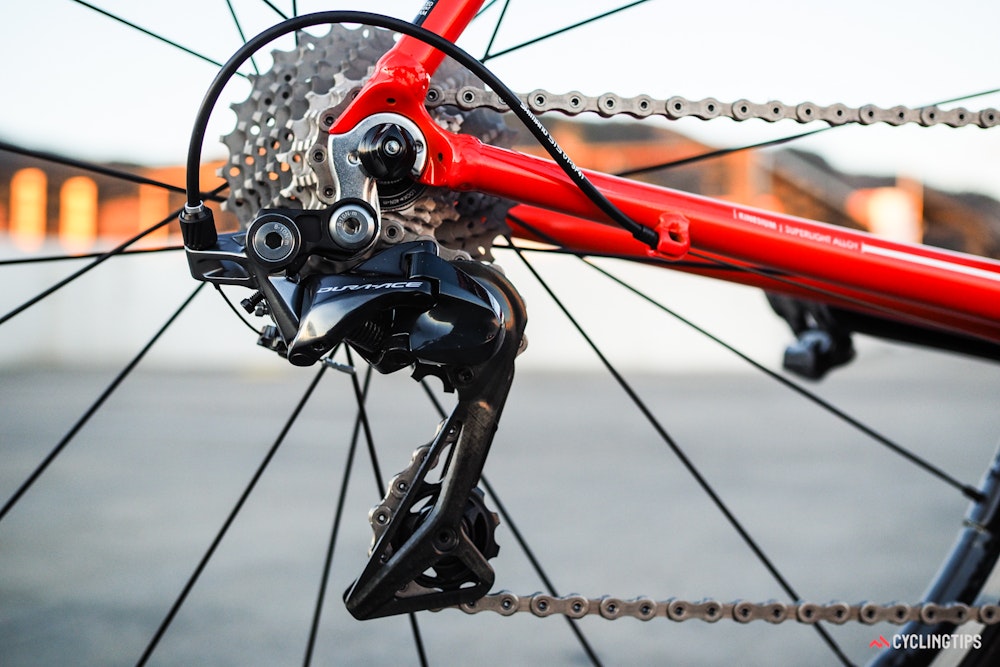
Shimano is showing clear disregard for convention with the new Dura-Ace 9100 rear derailleur. Its aesthetics may put some people off, but the elongated cage can now accept 30-tooth cogs, and the so-called Direct Mount upper link design will likely spawn a change in hanger design for faster wheel changes.
The changes also make the installation process easier, as it’s now more straightforward to set the chain gap, and the revised cable path yields a shorter loop of housing hanging in the breeze. Those revisions are subtle but significant on the road: that more constant chain gap makes for noticeably improved shift performance across the entire cassette spread, and quieter running regardless of gear selection. The revamped layout also helps tuck all the critical bits a little further inboard for a touch more protection in the event of a crash, but hopefully that isn’t something anyone will experience on a regular basis.
In addition to the rear derailleur’s distinctly mountain bike-like appearance, Dura-Ace 9100 also now boasts a slightly elongated pulley cage that can accommodate a 30-tooth cassette cog without having to swap to a separate mid-length cage option. Traditionalists will likely take issue with the elongated cage’s appearance, but it’s a big improvement in terms of versatility, and one that heavy-duty climbers will appreciate.
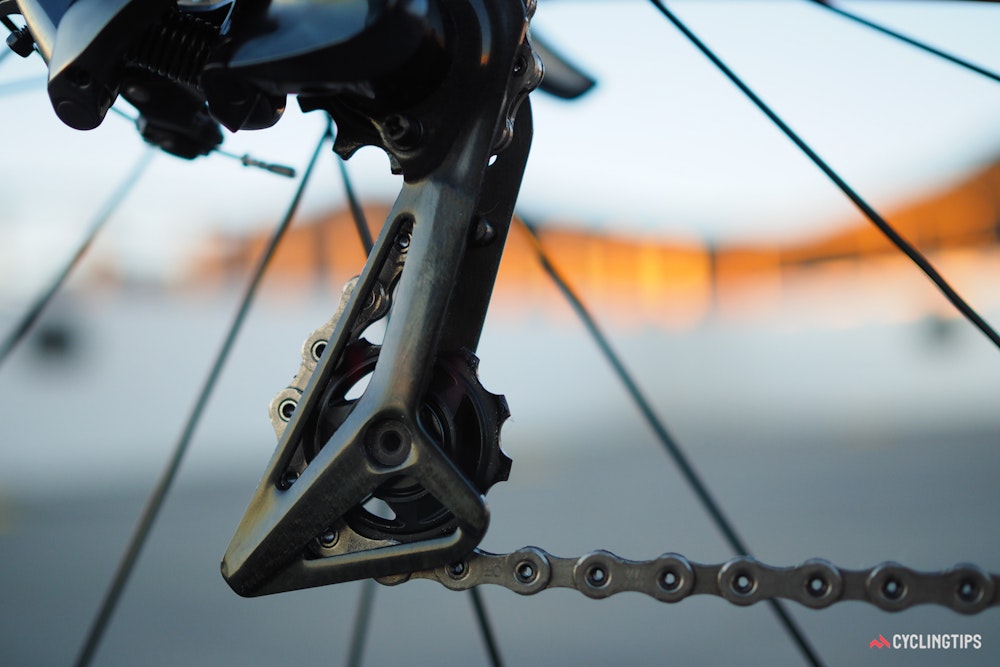
The carbon fiber pulley cage is admirably rigid.
Speaking of gearing, riders who previously opted for compact 50/34T chainrings and 11-28T cassettes for climbing prowess no longer have to sacrifice downhill speed to get it. Choosing the new 11-30T 11-speed cassette and mid-compact 52/36T chainrings will actually provide a slightly lower gear at the bottom end as well as nearly the same top-end gear as a standard 53/39T crankset.
The visual changes to the front derailleur are less obvious than what’s happened to the rear derailleur, but more profound functionally.
Shimano took a big leap forward on the previous-generation front derailleur, which used a then-radically long lever arm for the cable that dramatically shortened the shift-lever throw relative to Dura-Ace 7900. How well that design worked, however, could vary wildly depending on the cable entry angle from the bottom bracket, and it was always sensitive to cable tension.
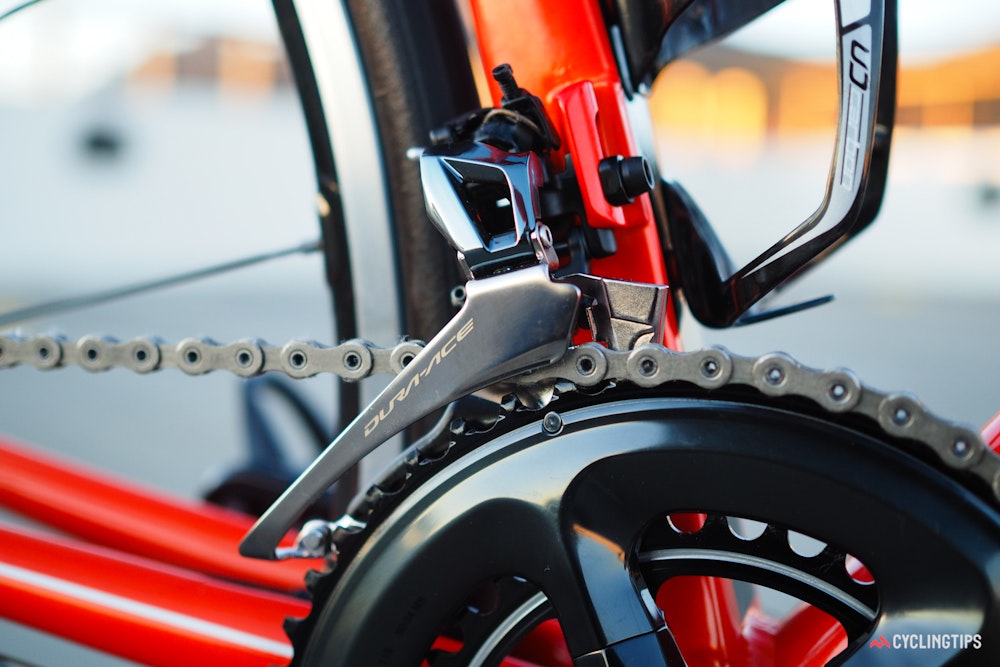
Shimano’s previous-generation Dura-Ace front derailleur design worked extremely well, but could sometimes be finicky to set up. The new front derailleur takes more time to install and adjust, but is far more tolerant of different cable entry angles.
With Dura-Ace 9100, Shimano has moved to a more complex secondary linkage that precisely alters the leverage ratio throughout the range of motion. This still provides the short lever throw up front, but without the finickiness. Setup is a bit more tedious — and even experienced mechanics will need to consult the installation video to do it properly — but more reliable provided you follow the directions. In addition, cable tension is adjusted by a screw on the derailleur itself (goodbye, inline cable adjusters), and there’s even a slick little widget to keep the cable end neatly tucked away.
I certainly appreciated the more foolproof setup process, but what I noticed more while riding was the consistently low effort required throughout the lever’s range of motion; the incredible shifting performance under power remains as present as ever. The more compact linkage assembly provides more tire clearance, too, and there’s never even the slightest chance of grazing your leg on the cable end while pedaling.
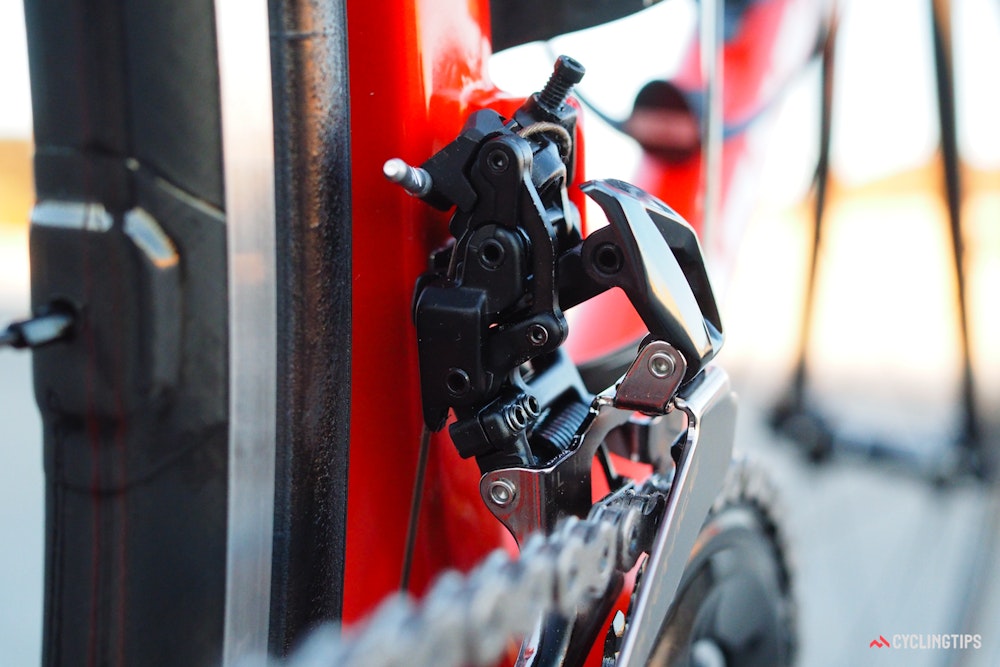
The front derailleur cage operates on one parallelogram linkage, but the cable pulls on its own complex arrangement. This allowed Shimano engineers to more finely tune the cable leverage ratio throughout the range of cage movement, resulting in more precise positioning and shorter shift lever throws.
As much of an improvement as the new front derailleur is — and as well as it works — I nevertheless still found myself occasionally longing for SRAM’s Yaw design out on the road with its ultra-clever, automatic angle-adjusting cage. Seasoned riders will have no issues with the Dura-Ace 9100 front derailleur’s two primary and two trim positions, but SRAM has managed to eliminate the need for trim positions altogether.
Even so, the new Dura-Ace front derailleur design is very well thought out, and quite possibly my favorite part of the group.
SIGHTS AND SOUNDS
It’s impossible to discuss the new Dura-Ace 9100 group without referencing its polarizing aesthetics. No other component company has championed the use of aluminum more than Shimano, and no surface treatment highlights that material more than a glimmering polish. Shimano hasn’t used that look since Dura-Ace 7800, though, and has been progressing moving toward the opposite end of the spectrum ever since. With Dura-Ace 9100, it’s completed the shift to the dark side.
To Shimano’s credit, the all-black finish is arguably more appropriate to modern frame and wheel designs, and it lends a more cohesive appearance with its mix of aluminum and carbon fiber composite construction. It looks serious and sinister, and much better in person than in pictures. It wouldn’t be fair to say that Shimano has gone this way to save money, either. All of the surfaces are still polished to a high luster; it’s just that they’re anodized black instead of given a clear anodized surface. Nothing about Dura-Ace 9100’s appearances even remotely suggest “cheap” in any way. Polarizing, yes, but certainly far from inexpensive.
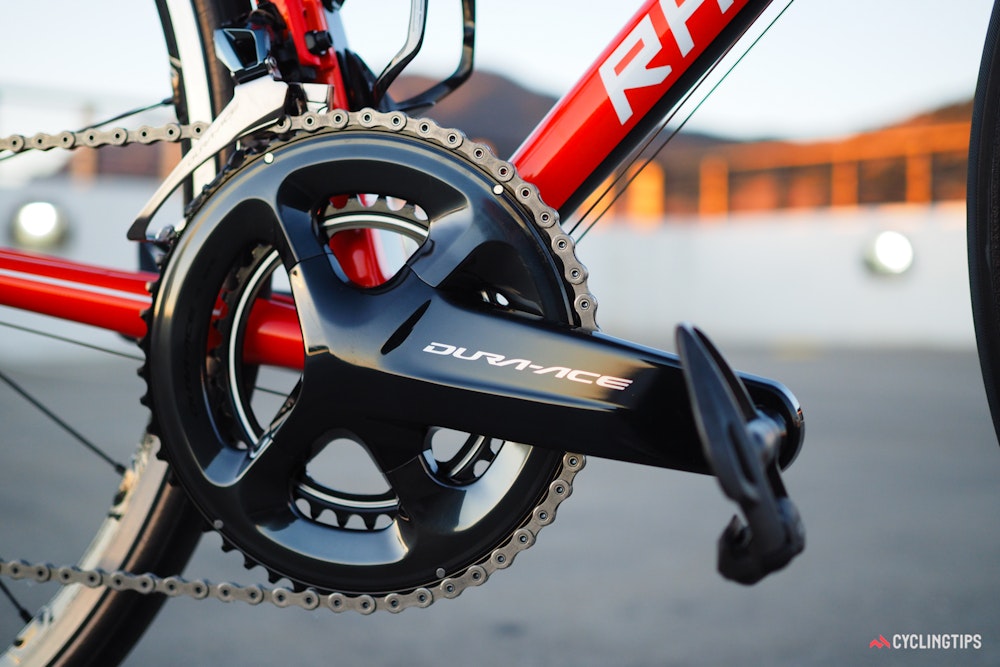
The new Shimano Dura-Ace 9100 crankset has gained an absolutely massive arm profile. The shape may be polarizing to some, but the dark finish will likely be even more so.
And then there’s that enormous new crankset. There are no ways to sugarcoat it; it’s huge, and the polished black finish doesn’t do much to diminish its bulky aesthetic. According to Shimano, the larger arm cross-sections increase the crankset stiffness without adding weight over its predecessor, while also specifically bolstering the chainring tab that’s subjected to the highest stress while pedaling. Truth be told, it isn’t something the vast majority of riders will notice while riding.
What they will notice, though, is the continued absence of a 30mm-diameter spindle option. Shimano will certainly argue on engineering terms the merits of a steel 24mm-diameter spindle over an aluminum 30mm one, and in terms of compatibility, there is no other crankset format that is more widely compatible with the current sea of bottom bracket standards. A 30mm-diameter spindle would perhaps have been nice, but it’s clear at this point that Shimano is sticking to its guns.
As for the unashamedly “techy” look of the new mountain bike-inspired rear derailleur, that’s once again standard operating procedure for Shimano. Save for perhaps the old Santé groupset of the late 1980s, Shimano’s offerings have always subscribed to a form-follows-function philosophy, so the lines of the new Dura-Ace 9100 groupset shouldn’t come as any big surprise.
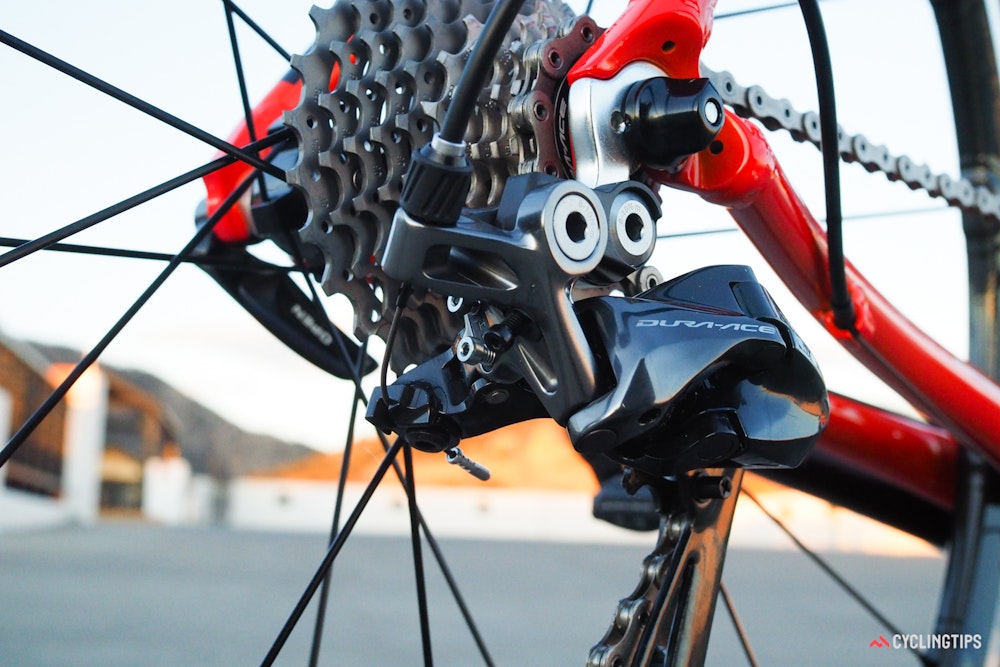
The cable path is far more direct on this latest Shimano Dura-Ace 9100 rear derailleur than the previous edition, which bodes well for cable durability. Limit screws have switched from Phillips heads to Allen heads, too.
One only has to switch their sensory focus from the eyes to the ears and hands to gain a better appreciation for that approach as the new drivetrain is eerily quiet. On the road, I heard the whooshing of my tires across the pavement more than the chain, with only the most extreme gearing combinations generating even a modest whir.
So far, the creaking cassette issues that have occasionally plagued 9000-generation Dura-Ace cassettes hasn’t popped up, although this is admittedly after just a week of hard use so it’s too early to draw any final conclusions. It’s also unclear whether Shimano has made any changes to the hybrid carbon composite and aluminum spider construction to ameliorate the issue, so only time will tell at this point.
DIMINISHING RETURNS
The obvious question here is whether it’s worthwhile for current Dura-Ace 9000 users to upgrade to Dura-Ace 9100, and to that, I would have to say probably not. Dura-Ace 9100 is better, but it’s not enough of an improvement to justify a wholesale switch. Thankfully, Shimano has made nearly all of the two groups cross-compatible, including the front derailleur, which in my opinion is the most worthwhile piecemeal upgrade. Just keep in mind that Shimano has altered the chainring spacing on the new crankset, which should be bundled with the new front derailleur.
Riders considering a new top-end component package, however, would certainly do well to consider Dura-Ace 9100. It’s the best mechanical road groupset Shimano has yet produced, and by far, the most refined cable actuated option on the market — SRAM Red 22 is lighter but less polished in execution, while Campagnolo Super Record speaks stronger to the emotions but doesn’t work as well. Ultimately, which of the three you choose will probably come down more to the style of shifter actuation than anything else.
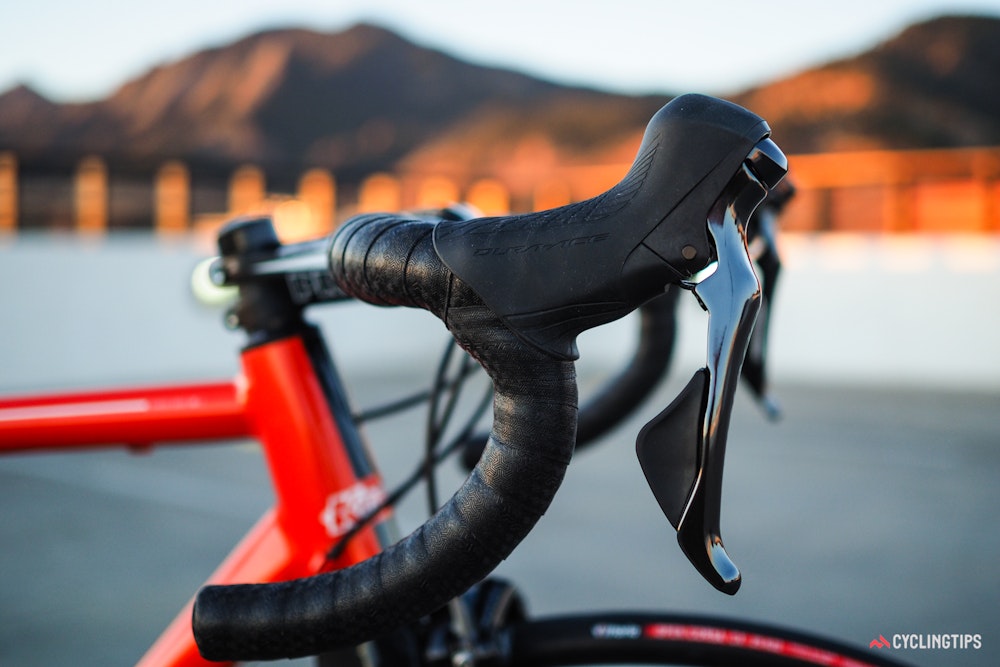
The lever bodies are impressively compact and pleasantly shaped with no sharp edges. Brake lever reach is set shorter straight out of the box, too.
DOING IT THE HARD WAY
In mathematics, an asymptote is a numerical value that a curve gets close to, but never quite reaches no matter how long the curve gets in space. You can divide the number one in half as many times as you’d like, for example, but the result will never equal zero. Similarly, perfection is something that product engineers always strive for, but is impossible to attain. This seems to be the philosophy of the minds behind Shimano’s Dura-Ace 9100. If the 9000 group was 98% perfect, 9100 is even closer. Call Dura-Ace 9100 evolutionary if you like, but I think it’s just as fair to call it revolutionary.
GOOD STUFF
- The ultimate in groupset refinement
- Superb front and rear shifting performance
- Outstanding brake power and modulation
- Quiet and smooth drivetrain
- Clever front derailleur design
- Wide range of gearing options
BAD STUFF
- Polarizing aesthetics
- Limited multi-shift capabilities
- No 30mm-diameter crankset spindle option
Follow BikeExchange: Email | Facebook | Twitter | Instagram | YouTube | STRAVA


